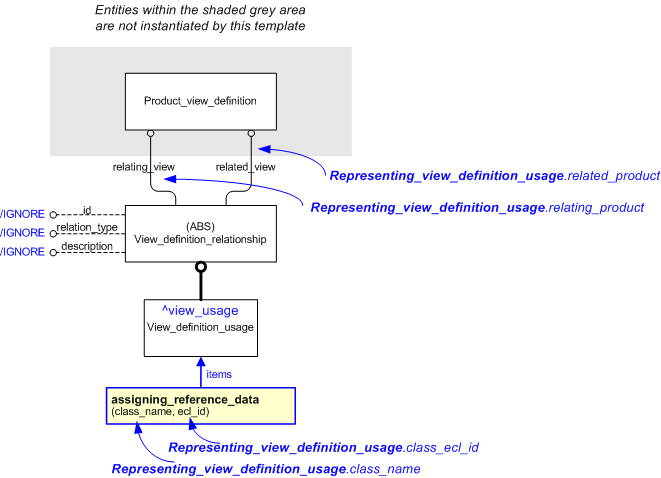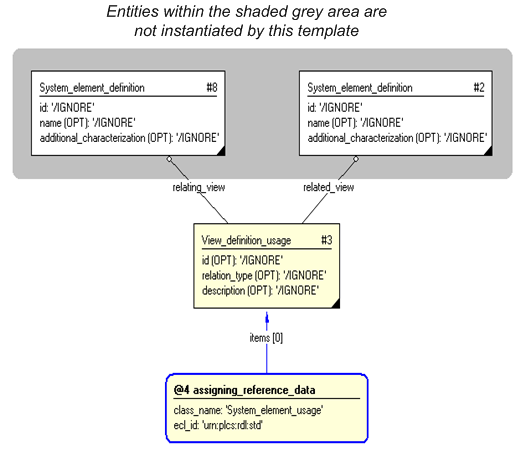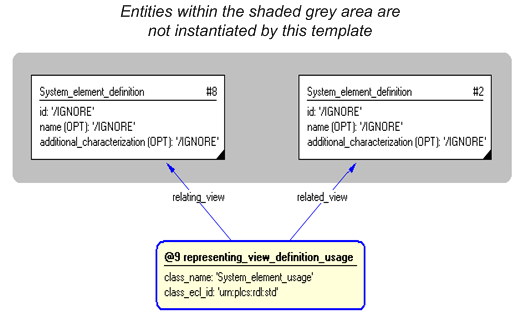| Template:— representing_view_definition_usage (rep_view_usage) |
Date: 2008/03/05 16:17:55
Revision: 1.4
|
This section specifies the template representing_view_definition_usage.
NOTE
An explanation of a template and the associated instantiation path is
provided in the
Template overview
section.
This template describes how to represent a relationship between two
Product_view_definitions, where
it is considered that the related product is used in the context of the relating product.
The EXPRESS-G diagram in
Figure
1
shows the templates and EXPRESS entities that are required
to represent the template
"representing_view_definition_usage".
The text highlighted in blue shows the template parameters.
Figure 1 — An EXPRESS-G representation of the Information model for representing_view_definition_usage
The graphic for the template to be used in other EXPRESS-G diagrams
is shown in Figure
2
below.
Figure 2 — The graphical representation of the representing_view_definition_usage template
The following input parameters are defined for this template:
The relating view definition. The meaning of the relating view definition is given by the
role of the
View_definition_usage,
see class_name below.
The related view definition. The meaning of the related view definition is given by the
role of the
View_definition_usage,
see class_name below.
The name of the
External_class that determines the role of the
relationship between the relating_product and the related_product.
The following classes and their sub-classes can be used:
The following reference parameters are defined for this template:
Allow the
View_definition_usage
entity instantiated in this path to be referenced when this template is used.
%^target = $representing_view_definition_usage.view_usage%
The instantiation path shown below specifies the entities that are to be
instantiated by the template.
A description of templates and the syntax for the instantiation path is
provided in the
Templates Help/Information section.
The following entities are instantiated with attributes as specified:
The instance diagram in Figure
3
shows an example of the EXPRESS entities and templates that are instantiated by the template:
/representing_view_definition_usage(relating_product='#8', related_product='#2', class_name='System_element_usage', ecl_id='urn:plcs:rdl:std')/
(an illustration of the consolidated representing_view_definition_usage template is shown in
Figure
4 below.)
Figure 3 — Entities instantiated by representing_view_definition_usage template
The instance model in STEP ASCII exchange file format (ISO 10303 Part
21 syntax) is:
#2 = SYSTEM_ELEMENT_DEFINITION('/IGNORE','/IGNORE','/IGNORE',$,(),$);
#3 = VIEW_DEFINITION_USAGE('/IGNORE','/IGNORE','/IGNORE',#8,#2);
#5 = CLASSIFICATION_ASSIGNMENT(#6,(#3),'/IGNORE');
#6 = EXTERNAL_CLASS('/NULL','System_element_usage','/IGNORE',#7);
#7 = EXTERNAL_CLASS_LIBRARY('urn:plcs:rdl:std','/IGNORE');
#8 = SYSTEM_ELEMENT_DEFINITION('/IGNORE','/IGNORE','/IGNORE',$,(),$);
The instance diagram in
Figure
4
shows the graphic symbol for the template that is to be
used in other instance diagrams. The example template is:
/representing_view_definition_usage(relating_product='#8', related_product='#2', class_name='System_element_usage', ecl_id='urn:plcs:rdl:std')/
Figure 4 — Instantiation of representing_view_definition_usage template
Characterizations
No common characterizations of the template
representing_view_definition_usage
have been identified. However, the ISO 10303-239 EXPRESS model
may enable other assignments to the entities instantiated by the template.




